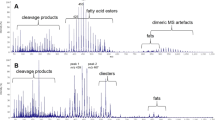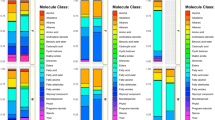Abstract
The chemical composition of secretions of precloacal pores from two populations of the lizard Liolaemus fabiani (Puilar and Punta-Brava) were compared. This is an endemic species from the Atacama Salt Flat (26°46'S 68°14'W; 2400 m) in northern Chile, restricted to the internal lakes of the salt flat. Interpopulational differences in the chemical composition of the secretions were expected considering that populations have genetic differences and are subject to different thermal conditions. By using GC-MS, a total of 44 compounds were found belonging to three categories: n-alkanes, long-chain carboxylic acids, and steroids. Six compounds were found in all the individuals studied: tetradecanoic, pentadecanoic, hexadecanoic, hexadecenoic, octadecanoic, and octadecenoic acids. The secretions of both populations had similar types and proportions of the different compounds, except for cholesterol and hexanoic acid, which were more abundant in the Puilar population. These differences can be ascribed to the different environmental conditions to which populations are subjected. The adaptive meaning of these differences is discussed.
Similar content being viewed by others
References
Alberts, A. C. 1990. Chemical properties of femoral gland secretions in the desert iguana, Dipsosaurus dorsalis. J. Chem. Ecol. 16:13–25.
Alberts, A. C. 1991. Phylogenetic and adaptive variation in lizards femoral gland secretions. Copeia 1991:69–79.
Alberts, A. C., Sharp, T. R., Werner, D. I., and Weldon, P. J. 1992. Seasonal variation of lipids in femoral gland secretions of male green iguanas (Iguana iguana). J. Chem. Ecol. 18:703–712.
Alberts, A. C., Phillips, J.A., and Werner, D. I. 1993. Sources of intraspecific variability in the protein composition of lizard femoral gland secretions. Copeia 1993:775–781.
Bull, C.M., Griffin, C.L., and Perkins, M.V. 1999. Some properties of a pheromone allowing individual recognition, from the scats of an Australian lizard, Egernia striolata. Acta Ethol. 2:35–42.
Bull, C. M., Griffin, C. L., Lanham, E. J., and Johnston, G. R. 2000. Recognition of pheromones from group members in a gregarious lizard, Egernia stokesii. J. Herpetol. 34:92–99.
Chauhan, N. B. 1986. A preliminary report on the lipid components of pre-anal gland secretion of lizards Hemidactylus flaviviridis and Uromastix hardwickii. J. Anim. Morphol. Physiol. 33:73–76.
Cooper, W. E., Jr. 1998. Evaluation of the swap and related tests as a bioassay for assessing responses by squamata reptiles to chemical stimuli. J. Chem. Ecol. 24:841–866.
Cooper, W. E., Jr. and Garstka, W. R. 1987. Lingual responses to chemical fractions of urodaeal glandular pheromones of the skink Eumeces laticeps. J. Exp. Zool. 24:249–253.
Cooper, W. E., Jr. and Vitt, L. J. 1986. Interspecific odour discrimination among syntopic congeners in scincid lizards (Genus Eumeces). Behavior 97:1–9.
Escobar, C. A., Labra, A., and Niemeyer, H. M. 2001. Chemical composition of precloacal secretions of Liolaemus lizards. J. Chem. Ecol. 27:1–14.
Etheridge, R. 1995. Redescription of Ctenoblepharys adspersa Tschudi, 1845, and the taxonomy of Liolaeminae (Reptilia: Squamata: Tropiduridae). Am. Mus. Novit. 3142:1–34.
Font, E. 1996. Los sentidos químicos de los reptiles. Un enfoque etológico. pp. 197–259, in F. Colmenares (ed.). Etología, Psicología Comparada y Comportamiento Animal. Síntesis Psicológica, Editorial Síntesis S.A., Madrid.
Ford, N. B. 1982. Species specificity of sex pheromone trails of sympatric and allopatric garter snakes (Thamnophis). Copeia 1982:10–13.
Ford, N. B. and Schofield, C. W. 1984. Species specificity of sex pheromones trails in the plains garter snake, Thamnophis radix. Herpetologica 40:51–55.
Johnstone, R. A. 1998. The evolution of animal signals, pp. 155–178, in J. R. Krebs and N. B. Davis (Eds.). Behavioral Ecology. Blackwell Science, London.
Labra, A. and Niemeyer, H. M. 1999. Intraspecific chemical recognition in the lizard Liolaemus tenuis. J. Chem. Ecol. 25:1799–1811.
Labra, A., Beltrán, S., and Niemeyer, H. M. 2001a. Chemical exploratory behavior in the lizard Liolaemus bellii. J. Herpetol. 35:51–55.
Labra, A., Escobar, C. A., and Niemeyer, H. M. 2001b. Chemical discrimination in Liolaemus lizards: comparison of behavioral and chemical data. pp. 437–444, in A. Marchlewska-Koj, F. Lepri, and D. Muller-Schwarze (Eds.). Chemical Sense in Vertebrates, Vol. 9. Kluwer Acedemic/Plenum Publishers, New York.
Labra, A., Soto-Gamboa, M., and Bozinovic, F. 2001c. Behavioral and physiological thermoregulation of Atacama desert-dwelling Liolaemus lizards. écoscience 8:413–420.
Labra, A., Escobar, C.A., Aguilar, P. M., and Niemeyer, H. M. 2002. Sources of pheromones in the lizard Liolaemus tenuis. Rev. Chil. Hist. Nat. 75:141–147.
LeMaster, M. P. and Mason, R. T. 2001. Annual and seasonal variation in the female sexual attractiveness pheromone of the red-sided garter snake, Thamnophis sirtalis parietalis, pp. 369–376, in A. Marchlewska-Koj, F. Lepri, and D. Muller-Schwarze (Eds.). Chemical Sense in Vertebrates, Vol. 9. Kluwer Acedemic/Plenum Publishers, New York.
Lynch, M. 1990. The similarity index and DNA fingerprinting. Mol. Biol. Evol. 7:478–484.
Mason, R. T. 1992. Reptilian pheromones, pp. 114–228, in C. Gans, and D. Crews (Eds.). Hormones, Brain and Behavior. Biology of Reptilia. The University Chicago Press, Chicago.
Mason, R. T. and Gutzke, W. H. N. 1990. Sex recognition in the leopard gecko, Eublepharis macularius (Sauria: Gekkonidae) possible mediation by skin-derived semiochemicals. J. Chem. Ecol. 16:27–36.
Pesyna, G. M., Venkataraghavan, R., Dayringer, H. E. and McLafferty, F. W. 1976. Probability based matching system using a large collection of reference mass spectra. Anal. Chem. 48:1362–1368.
Veloso, A. and Navarro, J. 1988. Lista sistemática y distribución geográfica de anfibios y reptiles de chile. Boll. Mus. Reg. Scie. Nat. Torino 6:481–539.
Zar, J. H. 1984. Biostatistical Analysis. Prentice-Hall, Englewood Cliffs, New Jersey, 718pp.
Author information
Authors and Affiliations
Corresponding author
Rights and permissions
About this article
Cite this article
Escobar, C.M., Escobar, C.A., Labra, A. et al. Chemical Composition of Precloacal Secretions of Two Liolaemus fabiani Populations: Are They Different?. J Chem Ecol 29, 629–638 (2003). https://doi.org/10.1023/A:1022858919037
Issue Date:
DOI: https://doi.org/10.1023/A:1022858919037




